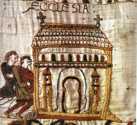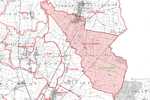 Danethorpe Danethorpe
Church
History
Around the year 1024, a moneyer named Thurkil Hoche gave land in Collingham to the Benedictine abbey of Peterborough, the first grant to the abbey which geographically considerably extended its endowment, being some forty-six miles distant. Although Danethorpe is not mentioned specifically in the transaction, the parish boundaries encompassed Danethorpe and Danethorpe Hill, and it is clear that the church here was, at least in part, appropriated to Peterborough Abbey in the medieval period.
Domesday Book records that Danethorpe (Dordentorp) was held by Ralph de Limesi in 1086 and that there was a church and a priest with one plough. The place was very small, having just five freemen and six smallholders recorded at this time, and was subsequently always associated with the neighbouring village of South Collingham.
The Herthill family had a major early involvement in the place but Adam de Herthill gave Roger Deyncourt and Alice his wife all his land and interests in Danethorpe sometime around the middle of the 13th century. In c1263, Alice, wife of the recently deceased Roger Deyncourt, along with Roger de Brettevile and Amabilia his wife, gave their interests to Thurgarton Priory, which was subsequently confirmed by a charter of Richard de Herthill.
In 1276 jurors of the county certified that the Knights Hospitaller held the manors of Deyvilthorpe (Danethorpe), Winkburn, Ossington, and 4s rent in Willoughby, as well as free warren in Ossington, Winkburn, and Danethorpe, and a park at Winkburn. In 1338, when Prior Philip de Thame made a return to the Grand Master of the English possessions of the Hospitallers, full particulars were entered of the Bajulia de Ossington, as well as of the smaller estate or camera of Winkburn, with its membrum (annexe) of Danethorpe. Danethorpe was said by the prior to have been part of the Hospitaller’s estate for such a long time that nobody could remember when, and his pleas were allowed. The messuage of Danethorpe owned by the Winkburn Knights Hospitaller, with its 68 acres of land, meadows, and pasture, was let out to farm at the annual rent of 10 marks (£6 13s 4d); however there is no mention of the church being part of the Hospitaller’s holdings.
Danethorpe is not recorded in the Pope Nicholas IV taxatio of 1291, either because it was too small in terms of income or, perhaps, because it was deemed to be part of the estate of the Knights Hospitaller, who were exempt from paying this tax. Neither does any entry appear fifty years later in the Nonae Rolls of 1341, presumably for the same reason.
It is likely that Thurgarton Priory held the living of the church throughout its history. There is record in 1280 that the Prior of Thurgarton, and the Abbot of Peterborough, agreed over services owed by tenants at Danethorpe on the abbot of Peterborough’s manor at Collingham. They also agreed that all the tenants of that Prior and Convent in Danethorpe should plough three times a year, and each plough was to have every day four loaves, and four herrings. Further details of the procedures for reaping and for the custody of sheep were also given. It was also stipulated that the people of Danethorpe were to attend the courts of Collingham ‘and the like’. The inclusion of the Abbot of Peterborough is of some interest, as at the Reformation it appears that Danethorpe was a part appropriation of Peterborough Abbey, and the Bishop of Peterborough later enjoyed the patronage of South Collingham, St John the Baptist; this no doubt arose from the early gift of land by Thurkil Hoche in 1024.
On 27 June 1329 there was an inspeximus and confirmation of a deed of one Thomas Larcher, the Prior, and the brethren of the Hospital of St John of Jerusalem in England. This deed granted to Henry de Edenestowe, clerk, for his outlay in improving the manor of Danethorpe, to whom it had been lately leased for life by the Prior and brethren. The lease was surrendered by him, along with the hay and crops growing there, believed to be of the value of 20 marks (£13 6s 8d), of a yearly rent of 12 marks (£8), out of the manor of Ossington. For his greater security, they granted to him 20s. by way of seisin [conveyance of a fee by deed of feofment], and they bound themselves and their successors to pay the said yearly rent to him for his life.
In 1337, a communal assessment for the payment of taxation refers to ‘Danethorpe Hill’, a place which still exists to the south of Danethorpe proper. This is still the case in 1463 where it appears listed next to South Collingham, and even as late as May 1624 the place was still being taxed.
In 1384/5 Philip Grey of Sandiacre held a messuage and 12 acres of land in Danethorpe. In 1399, John de Leek, knight, held a messuage and 12 acres of land in Danethorpe on behalf of the King, to whom was owed 22s 4d by the late John de Vaux, formerly sheriff and escheator, whose land it previously was, thus indicating that the village was of some importance in the late 14th century.
In the Valor Ecclesiasticus of 1535, Danethorpe-with-Collingham is valued at 36s 8d per annum gross, less payment of 10s to the Abbey of St Peter, Peterborough in Northamptonshire. Following the Dissolution, the manor of Danethorpe, which was deemed to have belonged to Thurgarton Priory, together with its lands, tenements, and appurtenances, both there and in South Collingham, which had been in the in tenure of Hugh Halvester, were granted to John Bellowe, and John Broxholme, and their heirs, on 4 July 1545.
At some point, probably in the late 16th century, Danethorpe became depopulated and exists now as the site of a deserted medieval village lying just to the south-east of the Fosse Way near Brough. A small church was constructed in 1885 in the hamlet of Brough to cater for the local population.
The antiquary William Stukeley mentioned the tradition that there was a church on a place called ‘Chapel Yard’, the location now lost to memory and unrecorded on maps. According to the Topographical Dictionary of England, published in 1848, human bones, with remains of coffins, have turned up at Danethorpe in a place called the ‘Chapel Close’, ‘where was formerly a chapel connected with the priory of Thurgarton’, although in Francis White’s History, Gazeteer, and Directory of 1864 it is stated that the chapel was formerly annexed to Hawton, and that £2 a year was still paid to the rector of Hawton out of Chapel Close. The location of Danethorpe in Hawton parish seems to be substantiated by two churchwardens’ presentments, in 1638 and 1640, both of which refer to Danethorpe as being within the parish; however, in 1637 and 1669, similar presentments deem Danethorpe to be within the parish of South Collingham. In William White’s Gazetteer of 1832 it was stated that ‘human bones are still frequently discovered in a garden which was the burial ground’. The exact position of Danethorpe church is currently unknown and a detailed archaeological survey of the area would be required to locate its site.
 Map showing pre-1851 Map showing pre-1851
parish boundaries |
In summary, it would appear most likely that Danethorpe formed part of South Collingham parish and that its lands were divided between Thurgarton Priory and, for some time, the Knights Hospitaller’s camera at Winkburn. The church however, which may well have existed prior to the Norman Conquest, possibly founded around 1024, was appropriated, at least in part, by Peterborough Abbey. After the Reformation the parish may, for some time in the 17th century, have formed part of Hawton parish though this is far from clear. In 1851 the parish boundaries indicate that it was still within South Collingham parish as indeed it remains today.
| 
 Map showing pre-1851
Map showing pre-1851





